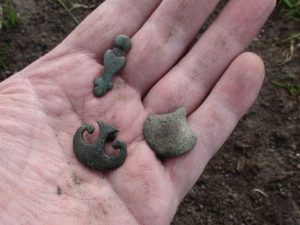Researchers excavating archaeological sites near the villages Gąski and Wierzbiczany in the Kuyavia region, North-Central Poland, came to a conclusion that Roman soldiers were present there. Unique finds of Roman cavalrymen’s equipment and soldier uniform’s parts never before found outside the Roman Empire seem to back up this thesis.

The complex of Iron Age sites was discovered due to involvement of metal detectorists, who handed over their findings to archaeologists. Majority of the artefacts was discovered in the area between the villages of Gąski and Wierzbiczany. Among the objects were numerous fittings made of bronze, which turned out to be parts of Roman cavalryman’s equipment and parts of Roman soldier’s outfit. Many of them are unique to this are of Europe, according to Bartosz Kątny, archaeologists of University of Warsaw. Excavations undertaken in the area by a team led by archaeologist Marcin Rudnicki uncovered more artefact of similar kind. Among the finds are metal pendants, which usually adorned the equipment of Roman cavalryman’s horse. They were shape as phalluses or vulvae, and served as amulets bringing luck and shielding from bad. A really unique artefact is a gold-covered bronze fitting of a belt, shaped like a beneficiarius‘s spear – spear of a high ranking Roman military officer. The archaeologist states it was a symbol of power.

The researchers admit, that such density of findings attributed to Romans must be a real testimony to their presence in this important regional, cultural and social centre, which might be connected with the Amber Road, as Romans valued this natural resource very high. According to the researchers, Roman might have come to the area for different reasons, depending on the time, as the age of the artefact spans from 2000 to 1600 years into the past. By the end of Antiquity they might have travelled deep into the Barbaricum to enlist new soldiers from the Germanic tribes for the Roman army. On the other hand, by the end of the 1st century AD, they might have come here invited by the Lugii (Vandals) tribe which needed aid in their wars with the Suebi. Archaeologists state that ancient sources, mainly Cassius Dio, mentions that the Emperor Domitian sent them a hundred cavalrymen as aid. The discovered artefacts might have belonged to one of such Roman riders.
(after Marcin Rudnicki & Nauka w Polsce)